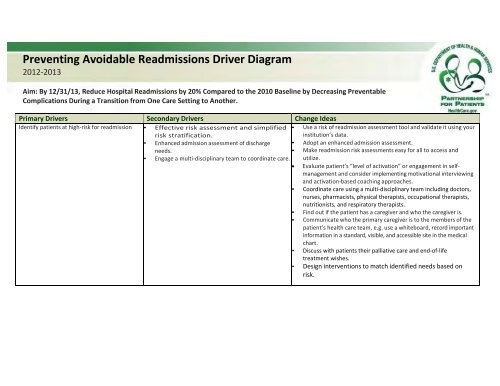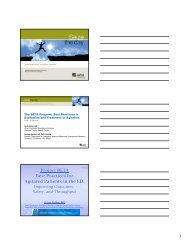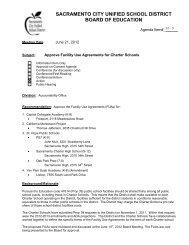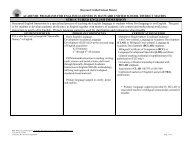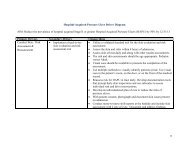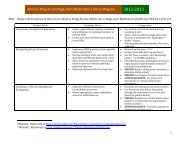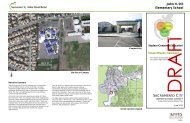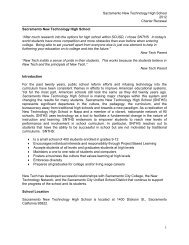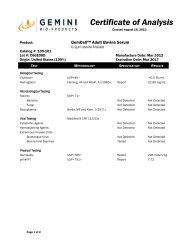Preventing Avoidable Readmissions Driver Diagram
Preventing Avoidable Readmissions Driver Diagram
Preventing Avoidable Readmissions Driver Diagram
You also want an ePaper? Increase the reach of your titles
YUMPU automatically turns print PDFs into web optimized ePapers that Google loves.
<strong>Preventing</strong> <strong>Avoidable</strong> <strong>Readmissions</strong> <strong>Driver</strong> <strong>Diagram</strong><br />
2012-2013<br />
Aim: By 12/31/13, Reduce Hospital <strong>Readmissions</strong> by 20% Compared to the 2010 Baseline by Decreasing Preventable<br />
Complications During a Transition from One Care Setting to Another.<br />
Primary <strong>Driver</strong>s Secondary <strong>Driver</strong>s Change Ideas<br />
Identify patients at high-risk for readmission • Effective risk assessment and simplified<br />
risk stratification.<br />
• Enhanced admission assessment of discharge<br />
needs.<br />
• Engage a multi-disciplinary team to coordinate care.<br />
• Use a risk of readmission assessment tool and validate it using your<br />
institution’s data.<br />
• Adopt an enhanced admission assessment.<br />
• Make readmission risk assessments easy for all to access and<br />
utilize.<br />
• Evaluate patient’s “level of activation” or engagement in selfmanagement<br />
and consider implementing motivational interviewing<br />
and activation-based coaching approaches.<br />
• Coordinate care using a multi-disciplinary team including doctors,<br />
nurses, pharmacists, physical therapists, occupational therapists,<br />
nutritionists, and respiratory therapists.<br />
• Find out if the patient has a caregiver and who the caregiver is.<br />
• Communicate who the primary caregiver is to the members of the<br />
patient’s health care team, e.g. use a whiteboard, record important<br />
information in a standard, visible, and accessible site in the medical<br />
chart.<br />
• Discuss with patients their palliative care and end-of-life<br />
treatment wishes.<br />
• Design interventions to match identified needs based on<br />
risk.
Primary <strong>Driver</strong>s Secondary <strong>Driver</strong>s Change Ideas<br />
Self-management skills • Enhance patients’/caregivers’ knowledge<br />
about the medications prescribed.<br />
• Enhance patients’/caregivers’ knowledge<br />
about their symptoms, red flags, and selfcare<br />
strategies.<br />
• Identify and address patients’ health literacy and<br />
activation levels.<br />
• Use Teach-back to validate patient understanding.<br />
•<br />
• Obtain an accurate home medication history from the patient and/or<br />
primary caregiver at admission.<br />
Educate patients/caregivers before discharge regarding all<br />
medications prescribed, the purpose of these medications,<br />
the means of obtaining them, and the instructions for taking<br />
them.<br />
• Provide clearly written medication instructions using health<br />
literacy concepts and culturally appropriate training<br />
materials.<br />
• Develop patient-centered educational tools that employ health literacy<br />
concepts to teach patients about their diagnosis and symptoms.<br />
• Train clinical staff on Teach-back using role play, and observe their<br />
technique in the field. Do they…<br />
o Use “I” statements when speaking with patients and<br />
caregivers? “To make sure I did a good job explaining<br />
your medications, can you tell me …?”<br />
o Validate patient and caregiver understanding of<br />
discharge instructions?<br />
Coordination of information along the care<br />
continuum<br />
• Create a patient-centered record.<br />
• Timely communication with members of the care<br />
team who are not hospital-based.<br />
•<br />
• Accurate medication reconciliation at<br />
admission, at any change in the level of care,<br />
and at discharge.<br />
• Evaluate best practices and resources and established<br />
tools such as the Project RED After Hospital Care Plan (AHCP) and<br />
Coleman Personal Health Record.<br />
• Determine which models will work in your organization.<br />
• Engage IT support for completing plans of care.<br />
• Determine where key information is to be stored and how it<br />
will be compiled to complete plans of care.<br />
• Obtain accurate information about patients’ primary care physicians<br />
at the time of admission.<br />
• Send completed discharge summaries to patients’ primary care<br />
physicians within 48 hours of discharge.<br />
• Use of a concise, standardized discharge transfer form.<br />
• Assign clear accountability for medication reconciliation and<br />
perform reconciliation at each transition of care; consider a home<br />
visit to educate patients/caregivers about their medications and to<br />
reconcile the medications in the patients’ homes.
Primary <strong>Driver</strong>s Secondary <strong>Driver</strong>s Change Ideas<br />
Ensure adequate follow-up and community<br />
resources are available.<br />
• Coordination with physician/other care provider<br />
to facilitate resources and follow-up needs. Postdischarge<br />
calls/visits for high-risk patients.<br />
• Integration organizations and identify or develop<br />
medical home capabilities.<br />
• Coordinate with skilled-nursing facilities<br />
• Determine the community resources for the special<br />
needs of the highly vulnerable populations.<br />
•<br />
• Prior to leaving the hospital, determine what post-discharge<br />
resources and appointments will be needed, and ensure they<br />
are addressed in the after-care plan.<br />
• Work with patients and care providers to determine any barriers<br />
to making and attending follow-up appointment(s).<br />
• Work with patients and caregivers to determine any barriers to<br />
other follow-up requirements such as medications, special<br />
diet, transportation needs, etc.<br />
• In addition to these hospital-driven elements, additional benefits<br />
have been demonstrated with post-discharge interventions such<br />
as: post-discharge phone calls, home visits, home health<br />
referrals, etc. Those patients who have the highest risk of<br />
readmission may also benefit from more intensive community<br />
resources and support.<br />
• Consider developing or launching programs for special populations,<br />
e.g. behavioral health patients, homeless patients, ESRD, HIVinfected,<br />
or other complex, high-risk populations.<br />
• Identify community-based organizations, resources available and<br />
service gaps needing to be addressed. Collaborate to meet patient<br />
needs.<br />
• For patients without a primary care physician (PCP), work with<br />
health plans, Medicaid agencies, and other safety net programs to<br />
identify PCPs. Consider follow-up clinics run by hospitalists or nurse<br />
practitioners if timely access to a PCP not available.
Implementation Guide to Reduce <strong>Avoidable</strong> <strong>Readmissions</strong> 6<br />
1 Website. Retrieved at: http://www.insigniahealth.com/solutions/patient-activation-measure<br />
2<br />
Website. Pages 32-42. Retrieved at: http://www.bu.edu/fammed/projectred/newtoolkit/3.%20How%20to%20deliver%20the%20RED%204.15.11.pdf<br />
3 Website. Retrieved at: http://www.caretransitions.org/documents/phr.pdf


